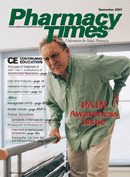Publication
Article
Pharmacy Times
A Pharmacist's Guide to OTC Therapy
Author(s):
Ms. Terrie is a clinical pharmacy writer based in Haymarket, Va.
Cold Sore Products
Herpes simplex labialis (HSL), alsocommonly referred to as cold sores orfever blisters, typically is caused by theherpes simplex virus 1 (HSV-1). HSV-2generally is responsible for causinggenital herpes. Either form of the virus,however, can cause cold sores or genitalherpes if the skin comes into contactwith it.
- Stress/fatigue
- Ultraviolet radiation due to extremeexposure to the sun
- Exposure to cold weather
- Fever and/or infections due to coldsor influenza
- Trauma due to recent dental work
- Menstruation, pregnancy, or otherhormonal changes
- Factors that may compromise theimmune system (chemotherapy, radiationtherapy, or immunosuppressantagents)
- Food allergies
TreatmentAn outbreak of HSL can negativelyimpact an individual?s quality of life.The primary goals in treating HSLinclude relief from pain and discomfort,prevention of transmission to others,and prevention of further complicationsor infections.Currently, docosanol 10% (Abreva;manufactured by GlaxoSmithKline) isthe only OTC product approved by theFDA to shorten healing time as well asboth the severity and the duration ofthe symptoms associated with HSL.This product inhibits direct fusionbetween the herpes virus and thehuman cell plasma membrane, thusaverting viral replication.1,2 It is intendedfor external use only by individuals12 years and older and should beapplied topically 5 times daily until thesore is gone.In addition, a number of topical OTCproducts?analgesics, antipruritics,anesthetics, and skin protectants?areavailable to provide symptomatic relief,but not for reducing the duration ofsymptoms1 (Table). The use of topicaltriple antibiotic ointments or systemicantibiotics may be necessary if thepatient has any signs of a secondaryinfection.1
- Use a cool, wet compress or ice onthe affected area at least 2 to 3 timesa day for 15 to 20 minutes to reduceswelling or erythema
- Keep lesions clean by routinelycleansing the affected area with amild soap solution
- Use skin protectants to keep lesionsmoist, because drying and crackingmay make the lesions more susceptibleto secondary bacterial infection
- Carefully wash the hands regularlywith warm water and soap
- Use sunscreen on the lips and facebefore exposure to the sun
- Avoid direct contact with otherswhen blisters are present, and avoidsharing personal items (towels,razors, silverware, etc)
- When possible, avoid known factorsthat may trigger outbreaks
- During outbreaks, avoid foods thatmay aggravate cold sores, such asacidic foods
- If not contraindicated, consider the useof an OTC analgesic to alleviate pain
- Cold sore lesions that are present formore than 14 days and those thatdisplay any signs of infection, such asfever, rash, or enlarged glands
- Increased incidence of cold sore outbreaks
- History of a compromised immunesystem
- Acetaminophen
- Acetylated salicylate
- Nonacetylated salicylates (cholinesalicylate, magnesium salicylate, andsodium salicylates)
- Nonsteroidal anti-inflammatory agents,such as ibuprofen and naproxen
Dosage forms include tablets, capsules,gel capsules, liquigels, enteric-coatedtablets, extended- or sustained-releaseforms, liquids, suspensions,effervescent tablets, suppositories,rapid-release-gel capsules, and chewabletablets. Formulations are availableas single-entity or combination products.Various formulations contain ananalgesic in combination with a decongestantfor individuals who suffer fromsinus headaches.
The Role of the PharmacistPharmacists can assist patients inthe proper selection of products(Tables 1 and 2), first ascertaining theappropriateness of self-treatment anddirecting patients to seek medicalintervention when warranted. Pharmacistsshould screen patients for possibleallergies and drug interactions, aswell as possible contraindications suchas renal and hepatic insufficiencies, ahistory of gastric ulcers, or coadministrationof anticoagulants.
Pharmacists always should counselpatients on the proper use, recommendedduration, and adverse effectsassociated with the use of these products.They should remind patientsabout the potential for reboundheadaches that may occur with medicationoveruse.
Pharmacists also should advisepatients to become familiar with factorsthat may possibly trigger theirheadaches and to avoid these triggerswhen feasible. Patients can incorporatevarious nonpharmacologic measuresthat may alleviate or reduce theincidence of headaches, such as relaxationtechniques and getting an adequateamount of sleep. In addition,patients should be encouraged to contacttheir primary health care providerif their headaches increase in intensityand frequency.
ReferencesCold Sore Products
1. Klasser G, Greene C. Oral pain and discomfort. In: Berardi RR, Kroon LA, McDermott JH, et al. Handbook of Nonprescription Drugs. 15th ed. Washington, DC: American Pharmacists Association; 2006:677-708.
2. Abreva Web site. Available at: www.abreva.com.
3. Cold Sore. Mayo Clinic Web site. Available at: www.mayoclinic.com/health/cold-sore/DS00358/DSECTION=3.
4. Cold Sores?Topic Overview. WebMD Web site. Available at: www.webmd.com/skin-problems-and-treatments/tc/Cold-Sores-Topic-Overview.Headache Products
1. Health Care Topics: Headache, Doctors of Internal Medicine Web site. Available at: www.doctorsforadults.com/topics/dfa_head.htm. Accessed July 3, 2007.
2. Remington T. Headache. In: Berardi RR, Kroon LA, McDermott JH, et al. Handbook of Nonprescription Drugs. 15th ed. Washington, DC: American Pharmacists Association; 2006:69-89.
3. Causes of Headaches. Excedrin Web site. Available at: www.excedrin.com/headache-causes.shtml. Accessed July 7, 2007.
4. Headache Types. Excedrin Web site. Available at: www.excedrin.com/headache-types.shtml. Accessed July 7, 2007.
5. Tension-type headaches. Bayer HealthCare Web site. Available at: www.aspirin.com/aoi/hfh/tension_type_en.html. Accessed July 7, 2007.
6. Headache. Neurology Channel Web site. Available at: www.neurologychannel.com/headache. Accessed July 5, 2007.
7. Headache. MedicineNet Web site. Available at: www.medicinenet.com/script/main/art.asp?articlekey=20628&pf=3&page=1.
8. Secondary Headaches. American Headache Society Web site. Available at: www.achenet.org/education/patients/SecondaryHeadaches.asp.
9. Headache. Merck Manual Web site. Available at: www.merck.com/mmpe/sec16/ch216/ch216a.html#CACCDJAH.







